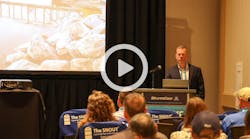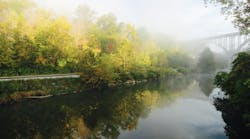
The indigenous Chamorro people of the Mariana Islands in the South Pacific have a traditional—and deadly—weapon called the slingstone. As described here, the oval-shaped stones were once carved from limestone or basalt or made from fire-hardened clay. Warriors suspended the stones from a sling, sometimes made from coconut fiber, and hurled them with great accuracy in battle. You can see the shape of the slingstone today on Guam’s flag, as well as in architectural and clothing designs throughout the island.
This historical weapon is getting a revival of sorts as part of an erosion control effort. The La Sa Fu’a watershed on Guam’s southwestern coast is experiencing severe erosion—the causes range from wildfires to herds of wild pigs that uproot vegetation and soil—and the resulting sediment washing into the ocean is damaging coral reefs. In an effort to plant more trees to anchor the soil, the Pacific Judicial Council, a group with members from various jurisdictions in Guam and neighboring islands, is encouraging the use of “seed slingstones.” These objects, about the size and shape of the traditional weapon, are made from a mixture of soil, compost, and seeds of daok or Australian pine trees.
Thousands of the objects have been literally slung into burned areas of the watershed. Government officials, campaigning politicians, and other dignitaries have been photographed in action. A group called Humåtak Watershed Adventures teaches groups of students and others how to make the slingstones, then leads them on hikes through the mountainous area to deliver them. The University of Guam’s Center for Island Sustainability is helping coordinate the effort.
About the Author
Janice Kaspersen
Janice Kaspersen is the former editor of Erosion Control and Stormwater magazines.

